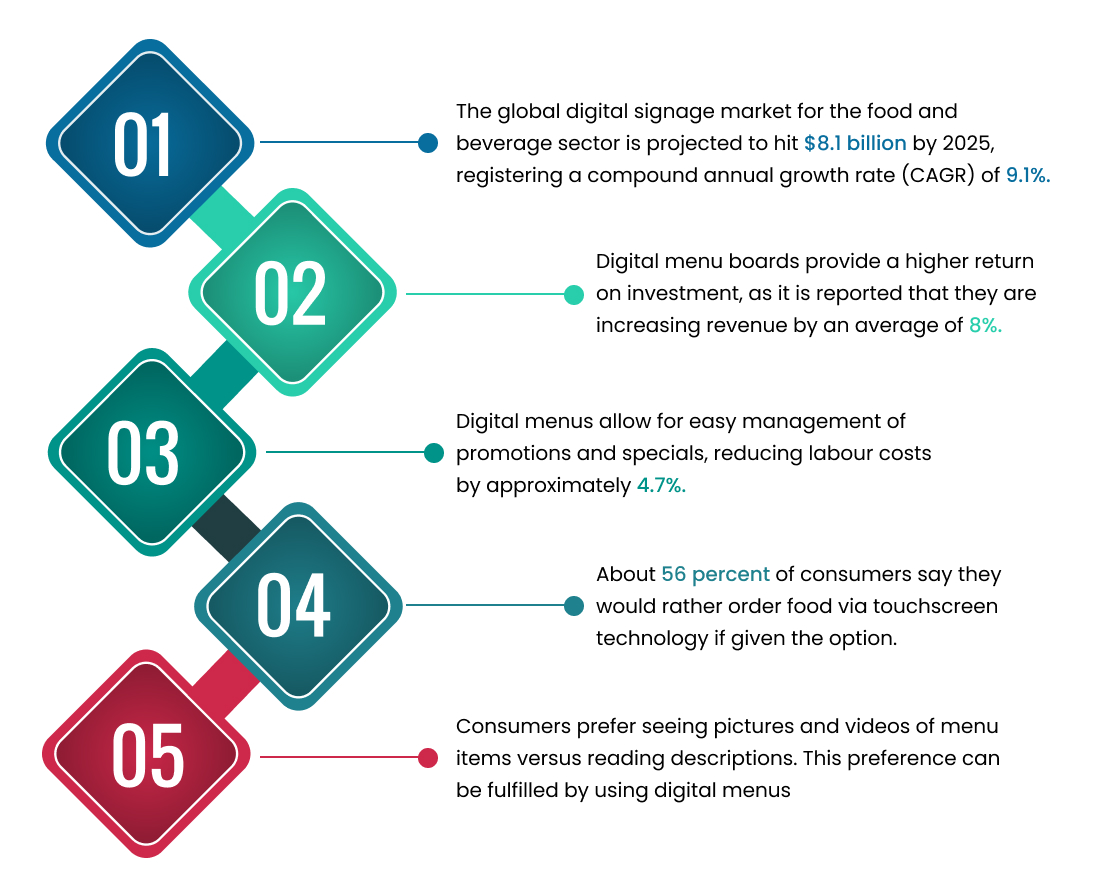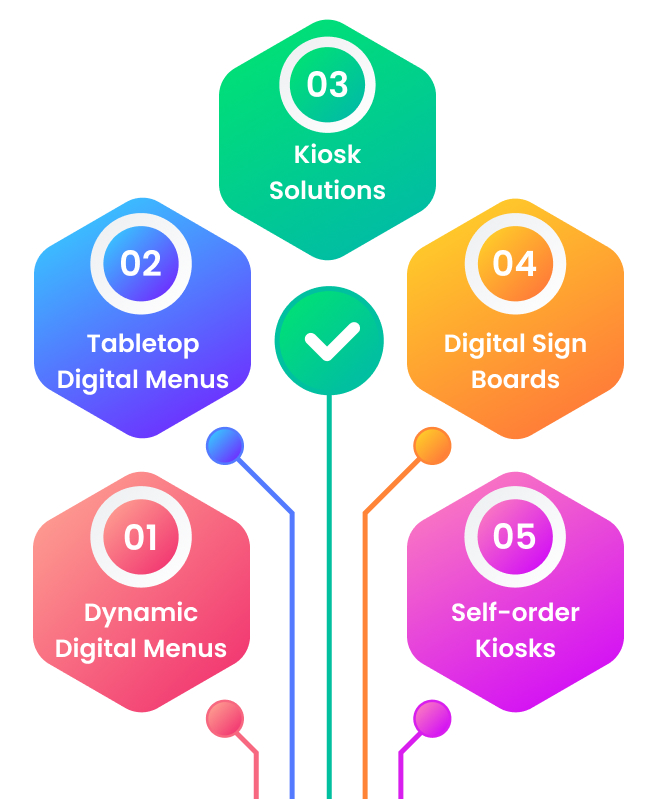Restaurant menus are the most crucial element or tool of any food industry. Menus are the internal guide and act as a communication tool that reflects a restaurant's quality, standards, and values.
Over the past few years, the food industry transforming at a high speed, and restaurants globally have seen immense competition in the market. Food business owners are opting for innovative technologies and automated systems to meet customer demands and expectations. One such innovation that all restaurants can not ignore is digital menus.
The Rise of Digital Menus
Nowadays, people are turning towards digital solutions, which in turn gave rise to digital menu boards. These menu boards are becoming a popular option for streamlining the food ordering process. Moreover, they offer a variety of benefits over traditional static menu boards and a great user experience.
Here are a few statistics on digital menus:

The Impact of Digital Menus on Restaurant Business
Digital menus can have a huge impact on the food industry. They allow easy customization and personalization of menu items, which can increase customer satisfaction and drive sales. They can also provide valuable insights into consumer behavior and preferences, allowing restaurants to make data-driven decisions.
Furthermore, they offer several advantages over traditional paper menus, such as easier management, lower costs, greater flexibility, improved branding opportunities, and better customer engagement through personalization and interactive features.
Benefits of Digital Menus in Restaurant
In today's fast-paced world, restaurants face significant challenges when attracting customers, improving operations, and increasing profits. One solution that addresses many of these issues is implementing digital menus. Digital menus offer numerous benefits compared to traditional printed menus, including improved efficiency, better communication with customers, scalability, eco-friendliness, and more.

- Scalability and standardization: These systems are highly scalable. With the growing competition in the food industry, it is good to have one centralized platform that is easy to modify at any time, even in remote units.
- Cost savings: Operating costs related to printing new menus are costly. But with digital menus, you do not have to worry about the cost. Digital menus update their prices as there is any change in the cost. In addition, waiting staff spend less time printing out daily specials, thereby increasing their guest interaction.
- Operational efficiency: Digital menu systems easily display real-time price changes, modifications, or promotions. This saves you a lot of time and money.
- Increased mobility: Tablets allow employees to move quickly and respond promptly to customers’ requests without leaving them alone. Therefore, servers can always take orders on time, which improves the overall fast food service experience.
- Better customer experiences: Interactive digital menus provide detailed descriptions of menu items, calorie counts, etc. This allows consumers to make informed decisions about their orders. Also, you can offer customers personalized recommendations based on their past purchases, enhancing the dining experience. These systems allow restaurants to deliver special offers or loyalty programs to their customers.
- Eco-friendliness and sustainability: Digital menus reduce paper usage and waste associated with traditional print materials. By automating menu management processes and reducing labor requirements, restaurants can save money.
- Real-time analytics and data collection: Analytics tools can track traffic patterns, popular menu items, and guest locations in real-time. Data analysis can inform future menu planning, inventory management, and staff scheduling. Tracking consumer behavior data provides insights into menu performance and ROI calculations.
- Future-proof infrastructure: Upgrading or changing signage hardware won’t require a costly campaign. This software can adapt to current hardware with API integration. Moreover, the new functionalities can be introduced without replacing existing ones, as only software updates are necessary to keep networks running smoothly.
Types of Digital Menus
Several different types of digital menus in restaurants, each offering specific benefits and serving various purposes.
Here's an overview of some common types of digital menus found in restaurants:

- Dynamic Digital Menus: These displays use dynamic content that changes based on the time of day, weather conditions, or external events like social media trends. They can display multimedia content such as images, videos, animations, and text in various languages. This type of digital menu is ideal for showcasing promotions, deals, and nutritional information in appealing ways.
- Tabletop Digital Menus: A more effective approach is to place compact Android tablets on the customers' tables. These menus display photos or videos of featured menu items with text describing their nutritional facts and transform regular tables into interactive ordering stations. Users can browse product galleries and customize their orders. It is the most effective type of digital menu because you can view ingredient sourcing and add comments.
- Kiosk Solutions: Self-service kiosks are becoming popular as they allow customers to access product catalogs, create virtual shopping lists, find locations within complex facilities, place orders remotely for pickup later, and handle self-checkouts without human interaction. Kiosks streamline the customer journey, save employees countless hours performing routine service tasks, and boost operational performance overall. Moreover, they display valuable data analytics helping managers optimize workflow, stock levels, and personnel schedules or identify trends requiring an adjustment in supply chain logistics.
- Digital Sign Boards: Digital sign boards in restaurants display promotions and pricing related to food and beverages. They grab the attention of walk-in guests while encouraging customers to consider add-ons like milkshakes or sodas. Also, you can adjust the brightness of the screens. Some models even play video ads, helping to sell complementary services to customers.
- Self-Order Kiosks: Self-order kiosks installed inside quick-service restaurants allow customers to browse menus, place orders, make modifications, add comments, or specify special requests for preparation techniques. Digital self-service kiosks help customers skip lines to talk directly to cashiers and scan barcodes from smartphones or loyalty cards instead of printing physical tickets and handling hard copies.
Unlocking the Potential of Digital Menus: Top Features That Make Them Stand Out
The adoption of digital menus has significantly increased over the past decade. Digital menus provide countless benefits compared to traditional ones. Here are the top features of digital menus that make them stand out in today's competitive market:

Interactivity: Modern customers demand high levels of engagement, and digital menus help you achieve that. With interactive menus, customers can navigate different types of media, such as videos and 3D animations, and interact with the information presented. Customers can select specific dishes, check product descriptions and reviews, and customize their orders based on their preferences.
Personalized Advertising: By using data gathered with the help of integrated platforms like loyalty programs and customer relationship management systems, digital menus can deliver personalized advertisements or recommendations to individual customers. Personalization helps create emotional connections with clients and, hence, enhances the sales rate.
Order Management Integration: One of the most crucial elements of a digital menu is its ability to integrate with point-of-sale (POS) systems. This integration allows seamless communication between front-end devices, kiosks, and back-office computers. Incorporating POS technology within the menu framework allows orders to quickly flow from the virtual platform to your kitchen display systems.
Versatility and Flexibility: Modern menu boards provide limitless options to adjust digital menus within a dynamic environment. Moreover, revising the menu takes minutes rather than hours with the help of digitization.
Cross-Platform Integration: One crucial aspect of digital menus is their integration with diverse systems. A fully integrated platform allows data sharing between different departments within an organization. As soon as an item sells out, the person responsible for handling inventory will know and can place the required orders. By utilizing cross-platform integration, organizations enable a data-driven culture and optimize operations.
Real-Time Management Information Systems: Many digital menu platforms incorporate robust management information systems that enable operators to monitor critical metrics and take action whenever needed. From understanding how different regions perform throughout the day to identifying menu favorites based on purchase patterns, real-time MIS provides information to the managers, so they can access live reports.
How to design a digital menu?
Designing a digital menu for a restaurant or café can seem like a daunting task at first glance. But by taking a systematic approach and considering some key factors, you can create a successful and user-friendly interface that enhances your customers’ dining experience.
- Choose the appropriate layout, font size, contrast, and colors. Also, organize the menu into different tabs based on the food category.
- Take advantage of menu engineering, which includes placing icons such as stars in front of your best or popular items.
- It is a good practice to write down detailed descriptions that customers find appealing.
- Digital menus offer the advantage of adding videos and photos of every dish. This help customers make better decisions.
- Have an optimized menu for different screen sizes and devices. It is good to go for responsive menus, as they automatically adjust themselves to the screen sizes.
Wrapping-up:
In conclusion, digital menus can streamline operations by reducing wait times for orders and providing easy access to menu modifications and changes.
Additionally, digital menus allow for greater flexibility in pricing and promotions, making it easier to adjust prices on a whim without incurring the costs associated with printing new physical menus.
Furthermore, they provide valuable data that can inform business decisions, such as tracking customer preferences and sales patterns. For customers, digital menus improve the dining experience by making ordering more efficient, allowing for customization options, providing accurate allergen information, and offering interactive features like real-time updates on waiting times.
So if you are looking for a digital menu that can help you increase profitability and improve customer satisfaction, jiMenu is here for you. It is a perfectly designed touchscreen digital menu system for restaurants, used by the food industry worldwide.












